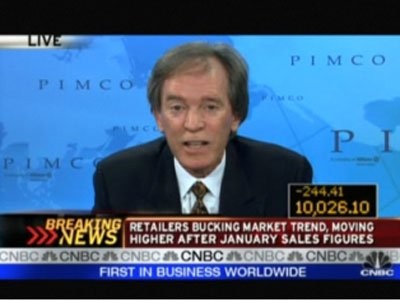PIMCO s Gross Asks Who Will Buy Treasuries When the Fed Doesn t
Post on: 19 Апрель, 2015 No Comment

The world’s biggest bond fund has dumped over $28 billion in U.S. Treasury securities since January. Pacific Investment Management Co.’s (PIMCO) Bill Gross, founder and co-chief investment officer, defends this move in his March investment outlook. He firm’s flagship Total Return Fund has reportedly shed its entire stash of Treasuries from 12% of assets to zero. In his outlook Gross explains that he does not believe the Federal Reserve will continue purchasing Treasuries aggressively with a third round of quantitative easing, after its second round of purchases ends in June. He wonders, Who will buy Treasuries when the Fed doesn’t?
In the outlook, Gross provides a little graphic showing how Treasury buying has evolved over the past few years. It shows that, in the recent past, the Fed purchased 10% of Treasuries, Foreign investors purchased 50%, and U.S. investors purchased 40%. Currently, that has shifted to the Fed purchasing 70% and foreign investors purchasing 30%, with negligible investment by U.S. investors. The chart concludes with a future picture where the Fed exits the market and foreign investors continue purchasing 30%. Who, he wonders, will purchase the other 70%?
Gross writes:
I don’t know. Reserve surplus sovereigns are likely good for their standard $500 billion annually but the banks are now making loans instead of buying Treasuries, and bond funds are not receiving generous inflows like they were as late as November of 2010. Who’s left? Well, let me not go too far. Temporary voids in demand are not exactly a buyers’ strike. Someone will buy them, and we at PIMCO may even be among them. The question really is at what yield and what are the price repercussions if the adjustments are significant. Fed Vice Chairman Janet Yellen in a speech just last week confirmed the theoretical rationale that Treasury yields are directly linked to the outstanding quantity of longer-term assets in the hands of the public. If that quantity is suddenly increased in one year as the charts imply, what are the yield consequences? What I would point out is that Treasury yields are perhaps 150 basis points or 1½% too low when viewed on a historical context and when compared with expected nominal GDP growth of 5%. (his emphasis)
If Treasury yields do rise, then prices would fall — which explains why Gross wouldn’t want to be left holding a big sack of the U.S. debt after June. And moreover, if yields do rise, he would be better off purchasing more Treasuries at that time with the cash he obtained by selling his current holdings.
This news didn’t exactly shake the Treasury market today, however. Dave Kansas at the Wall Street Journal’s MarketBeat reports that Treasury prices actually rose this afternoon. As he says, this likely just indicates even a giant the size of PIMCO isn’t big enough to move it. Rising oil prices are also driving investors to favor safe U.S. debt, due to the fear of their causing a double dip.
Still, this is a pretty notable move by Gross. As he says, certainly someone will buy Treasuries. But the supply isn’t going to slow much over the next few years as federal deficits remain high. And without the artificial demand created by the Fed, yields will almost certainly have to rise significantly. That is, unless the economy does take a step back.
And that’s where Gross’ strategy becomes a little clouded. Gross doesn’t appear to think that the recovery will cruise along safely after the Fed removes its training wheels in June. But if the market stutters without the Fed’s buying, won’t that drive more Treasury demand on the part of investors, replacing some or all of the Fed’s purchases? Treasury yields would rise the most if the slow recovery moves forward without the Fed at that time, which would occur if the U.S. economy stays the course even without another round of quantitative easing.














